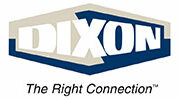There are numerous reasons why a hydraulic hose can fail. More often than not, the most common failures are ones that could have been avoided with proper precautions. At National Hose & Accessory, we utilize OnGuard™™ Hose Safety to work closely with customers and educate them on how the program helps you avoid costly equipment downtime, maintenance costs and reassure you that your hoses are working efficiently and safely — all within compliance of OSHA/EPA standards.
1. Tube Erosion
Hydraulic hose tube erosion often causes external leakage. Tube erosion is typically caused by a concentrated high-velocity stream of fluid or by small particles in the fluid.
2. Fluid Compatibility
System contamination and external leakage can be a direct result of fluid incompatibility. Incompatible fluids will cause the inner tube of the hydraulic hose assembly to deteriorate, swell, and delaminate (divide).
It is important that you make sure that the hose you order must be compatible with the fluid being moved. It is also important to make sure that while the fluid is compatible with the inner tube of the hose, that it is also compatible with the outer cover, fittings, and even O-rings as well. To ensure that your medium is the correct one for your hose, please check OnGuard™™ Asset Management’s Chemical Resistance Chart for hose.
3. Dry Air / Aged Air
The inner tube of hoses can develop numerous tiny cracks due to aged or dry air. This type of hose failure is sometimes hard to spot because your hydraulic hose will still remain flexible. Typically there are no signs of cracking on the hose under the fittings.
To avoid aged or dry air problems, confirm that your hose is rated for extremely dry air. Hoses that have inner tubes of PKR or EPDM rubber are preferred for these specific applications.
4. Minimum Bend Radius
Hose assemblies can fail relatively quickly if the minimum bend radius is not met.
In vacuum or suction applications, for example, if the bend radius has been exceeded the hose may tend to be flat in the bend area. This will hinder or restrict flow. If the bend is severe enough the hose may kink. To prevent bend radius hose failures, double check the recommended bend radius. Replace hose assemblies and change routing, length, or fittings to route the house within the published minimum bend radius if they do not comply.
5. Insertion Depth
When a hose assembly is not properly assembled, it can create very dangerous situations. Fittings need to be pushed on completely to meet the proper insertion depth. If insertion depth is not met, fittings can blow off and leave a failed hose assembly behind. The last grip in the fitting she is essential to the holding strength of the hose assembly.
6. Improper Assembly
Contamination can cause several problems for a hydraulic hose assembly. If not properly flushed, metal particles and debris can settle inside the hose. This abrasive debris left inside the hose will contaminate the hydraulic system. This contamination can also cause small fractures to occur on the inner tube of the hose assembly, resulting in leakage.
To prevent hose failures from contamination, the hose must be properly cleaned before inserting the fittings. The inner tube should be “squeaky-clean” before fittings are inserted. After the fittings are crimped, be sure to cap the ends in order to keep the hose clean and avoid recontamination during transport.
7. Heat Aged
Overheating a hose assembly can cause hose failure by causing the hose to become very stiff. The inner tube hardens and begins to crack because the plasticizers in the elastomer will break down or harden under the high temperature.
In some cases, the cover may show direct signs of being dried out. The hose assembly may remain in its installed shape after being removed from the application and if flexed, an audible cracking can be heard.
To prevent overheated hydraulic hose assemblies, confirm that hoses are rated for the temperatures required by your application. Also, reduce ambient temperatures or use heat guards and shields to protect the hose from nearby high-temperature areas.
8. Abrasion
Hydraulic hoses are put through rigorous applications every day, which eventually take their toll. If not inspected on a regular basis, abrasion can cause a hose assembly to burst or leak.
The cover of your hose is meant to protect it. So signs of damage to that cover or reinforcement layers should warn you that something is wrong. With a little background knowledge and training, many hose failures can be prevented.
OnGuard™™ Hose Safety offers hose safety training and hose product seminars on a regular basis. We know you can’t afford the downtime at factories by traveling, so we often provide safety training on-site at customer designated locations. We train staff from every department including maintenance, engineering, safety/environmental (HSE) and manufacturing teams.









